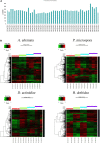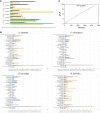The antifungal activity and mechanism of silver nanoparticles against four pathogens causing kiwifruit post-harvest rot
- PMID: 36118196
- PMCID: PMC9471003
- DOI: 10.3389/fmicb.2022.988633
The antifungal activity and mechanism of silver nanoparticles against four pathogens causing kiwifruit post-harvest rot
Abstract
Post-harvest rot causes enormous economic loss to the global kiwifruit industry. Currently, there are no effective fungicides to combat the disease. It is unclear whether silver nanoparticles (AgNPs) are effective in controlling post-harvest rot and, if so, what the underlying antifungal mechanism is. Our results indicated that 75 ppm AgNPs effectively inhibited the mycelial growth and spore germination of four kiwifruit rot pathogens: Alternaria alternata, Pestalotiopsis microspora, Diaporthe actinidiae, and Botryosphaeria dothidea. Additionally, AgNPs increased the permeability of mycelium's cell membrane, indicating the leakage of intracellular substance. Scanning electron microscopy (SEM) and transmission electron microscopy (TEM) observations revealed that AgNPs induced pathogen hypha shrinkage and distortion, as well as vacuolation in hypha cells, implying that AgNPs caused cellular and organelle structural degradation. The transcriptome sequencing of mycelium treated with AgNPs (24 h / 48 h) was performed on the Illumina Hiseq 4000 sequencing (RNA-Seq) platform. For the time points of 24 h and 48 h, AgNPs treatment resulted in 1,178 and 1,461 differentially expressed genes (DEGs) of A. alternata, 517 and 91 DEGs of P. microspora, 1,287 and 65 DEGs of D. actinidiae, 239 and 55 DEGs of B. dothidea, respectively. The DEGs were found to be involved in "catalytic activity," "small molecule binding," "metal ion binding," "transporter activity," "cellular component organization," "protein metabolic process," "carbohydrate metabolic process," and "establishment of localization." Kyoto Encyclopedia of Genes and Genomes (KEGG) analysis also revealed that "carbohydrate metabolism," "amino acid metabolism," "energy metabolism," and "xenobiotics biodegradation and metabolism" of "metabolism processes" were the most highly enriched pathways for these DEGs in four pathogens, with "cellular processes" being particularly enriched for B. dothidea. Furthermore, quantitative polymerase chain reactions (qPCRs) were used to validate the RNA-seq results. It was also confirmed that AgNPs could significantly reduce the symptoms of kiwifruit rot without leaving any Ag+ residue on the peel and flesh of kiwifruit. Our findings contributed to a better understanding of the antifungal effect and molecular mechanisms of AgNPs against pathogens causing kiwifruit post-harvest rot, as well as a new perspective on the application of this novel antifungal alternative to fruit disease control.
Keywords: antifungal activity; kiwifruit post-harvest rot; microstructure observation; nanoparticles; transcriptomic analysis.
Copyright © 2022 Li, Pan, Deng, Qian, Wang, Li and Zhong.
Conflict of interest statement
The authors declare that the research was conducted in the absence of any commercial or financial relationships that could be construed as a potential conflict of interest.
Figures






References
-
- Abdelmalek G. A. M., Salaheldin T. A. (2016). Silver nanoparticles as a potent fungicide for citrus pytopathogenic fungi. J. Nanomed. Res. 3:00065. 10.15406/jnmr.2016.03.00065 - DOI
-
- Akther T., Hemalatha S. (2019). Mycosilver nanoparticles: Synthesis, characterization and its efficacy against plant pathogenic fungi. Bionanoscience 9 296–301. 10.1007/s12668-019-0607-y - DOI
-
- Aldabe J., Santamaría C., Elustondo D., Lasheras E., Santamaría J. M. (2013). Application of microwave digestion and ICP-MS to simultaneous analysis of major and trace elements in aerosol samples collected on quartz filters. Anal. Methods 5:554. 10.1039/C2AY25724F - DOI
-
- Alothman M., Abd-Ei-Aziz Abeer R. M. (2019). Effect of green synthesis silver nanoparticles from five fruits peel on protein capped and anti-fungal properties. Int. J. Adv. Res. Biol. Sci. 6 156–165. 10.22192/ijarbs.2019.06.02.018 - DOI
LinkOut - more resources
Full Text Sources

